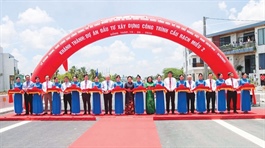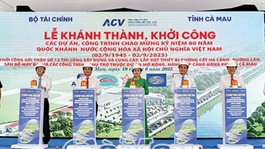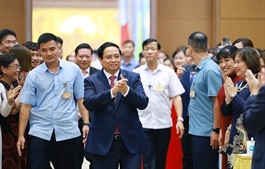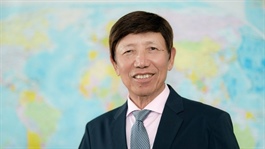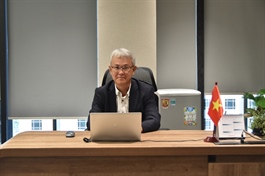Việt Nam’s next leap must be green, inclusive, and institution-driven: World Bank
Việt Nam’s next leap must be green, inclusive, and institution-driven: World Bank
Mariam J. Sherman, the World Bank’s Division Director for Việt Nam, Cambodia and Lao PDR, tells Vietnam News Agency how reforms, resilience and global integration fuelled Việt Nam's rise in the past few decades.
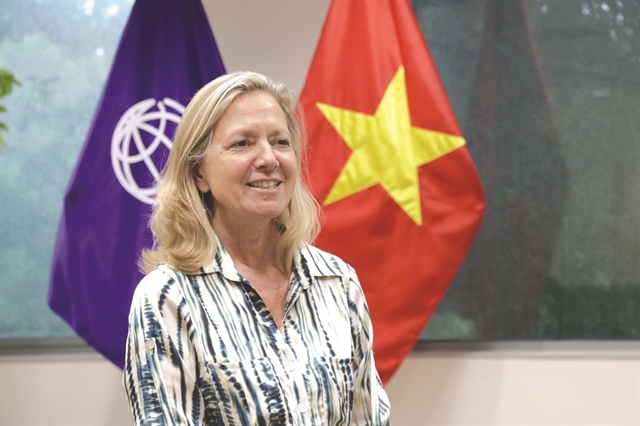
ADVOCATE: Mariam J. Sherman, World Bank Division Director for Việt Nam, Cambodia and Laos. VNA/VNS Photo |
Mariam J. Sherman, World Bank Division Director for Việt Nam, Cambodia and Laos, talks with Vietnam News Agency on the development success story of Việt Nam in the past eight decades, and the World Bank Group's commitment to continued assistance for Việt Nam in its aspirations to become a high-income nation.
Looking back on Việt Nam’s 80-year development journey, what do you consider to be the most significant economic achievements and transformative changes that have shaped its rise to a highly open, middle-income economy in the region?
Việt Nam’s progress since mid-1980s is one of the world’s most remarkable development stories – from one of the poorest in the world to a vibrant middle-income economy in under four decades.
For example, let's take a look at some numbers, starting with extreme poverty, which once affected more than half the population, is now below 1 per cent. Real incomes have risen six-fold and life expectancy has increased by 7 years since the early 1990s.
Perhaps the most striking change is Việt Nam’s global integration. Trade now exceeds 160 per cent of the national GDP, among the highest ratios in the world, thanks to its deep integration into global supply chains, from textile and footwear to electronics.
These changes are also reflected in people’s lives. Việt Nam has a 57-million-strong workforce, more than 20 million new jobs created since the 1986 reforms, and over 80 per cent now employed in the private sector.
From the World Bank’s perspective, this is a story of vision, perseverance, and reforms that has delivered real outcomes for people. We are proud to have been a partner over the past more than 30 years, providing technical support and nearly US$26 billion in financing to support the country’s profound transformation.
These achievements give Việt Nam a powerful springboard for the next stage of its journey to realise the ambition of becoming a high-income, green, and inclusive economy by 2045.
Could you highlight some of the key milestones in the partnership between the World Bank and the Government of Việt Nam over the past decades, particularly in supporting the country’s economic reform and development efforts?
The World Bank’s partnership with Việt Nam spans more than three decades, almost as long as the country’s reform journey itself. Since the early days of reform, we have been privileged to accompany Việt Nam through each stage of its transformation.
In the 1990s, support focused on foundational reforms – land, trade, investment, poverty reduction and finance – that helped create the conditions for transitioning from a centrally planned economy to a market-oriented system. Among these conditions, it was critical to recognise, legitimise, and reinforce the roles of market incentives and private sector growth for development.
Over time, we have provided nearly $26 billion in financing, coupled with policy advice and global knowledge in critical sectors, to support the country’s development priorities.
Together, we’ve invested in infrastructure, education, health, agriculture and social protection, helping to create millions of jobs and improve opportunities for Vietnamese people across the country.
During the last decade, we have worked with the government on climate resilience in the Mekong Delta, renewable energy expansion, and building resilient, sustainable cities to prepare for the future.
Some highlights of WB’s knowledge and financial support to Việt Nam over the years include programmes on electrification (now at 99 per cent coverage), rural transport and local road management, rural water supply, and Mekong climate resilience development. There was also a series of 10 Poverty Reduction Support Credit operations – helping build key institutional foundations for a market-oriented economy and, most recently, the Việt Nam 2035 and Việt Nam 2045 comprehensive reports.
Throughout, our partnership has always been about more than just financing. It’s about sharing knowledge and global expertise, so that Việt Nam can shape reforms that are its own, while still drawing on the best experiences from around the world. Given Việt Nam’s impressive development in the past four decades, the country has started to share its experiences with many other countries.
Institutional reform remains a central focus of Việt Nam's development agenda. What is your opinion about this?
Strong institutions are the backbone of sustained development. Research shows countries that successfully transition to high income all share one thing in common: effective and accountable institutions.
Việt Nam has already made important progress by consolidating provinces, streamlining administrative structures through mergers of ministries and departments, and piloting digital government. These reforms matter because they are expected to enhance effectiveness and efficiency, including reduction of red tape for both citizens and businesses.
As the economy becomes larger in size and more sophisticated in structure, stronger institutions will be vital to sustaining strong growth.
The critical shift will be for the state to move from directly driving economic activity to enabling it – creating a transparent, predictable and rules-based environment where the private sector can thrive.
This means a high-performing civil service, fair enforcement of rules, and strong mechanisms for accountability.
Every Vietnamese đồng of investment becomes more productive with better governance. Trust grows when rules are transparent and predictable, and businesses are more willing to invest in a well-functioning market environment.
The World Bank Group stands ready to support the government in building institutions that match the scale of its ambitions. Ultimately, strong institutions will be the bridge between Việt Nam’s 2045 ambitions and results on the ground.
What is your assessment of Việt Nam’s economic growth prospects and resilience, especially in the context of global uncertainties and structural transitions?
Việt Nam enters this next stage from a position of strength, having shown remarkable resilience and maintaining growth through previous shocks.
The global landscape presents a sobering backdrop. The World Bank projects global growth of about 2.3 per cent in 2025; trade tensions have intensified, we see that daily, and economic policy uncertainty is at its highest in decades.
For an export-driven economy like Việt Nam that is deeply integrated into global value chains, shifts such as “friend-shoring” and rising foreign trade barriers pose real challenges. The era of easy export-led growth is closing fast.
So what does this mean? To reach high-income status by 2045, research shows Việt Nam would need to lift per-capita growth to around 6 per cent every year for the next two decades, and avoid the middle-income trap that has slowed many peers.
The path forward from our perspective is quality growth, not just faster growth: higher productivity supported by quality infrastructure, innovation, digitalisation, and high-skilled workforce; and moving up the value chain beyond labour-intensive and low-skilled manufacturing, while diversifying growth drivers and deepening regional partnerships.
The good thing is Việt Nam’s advantages are real: a young and talented workforce, macroeconomic stability, a strategic location in Asia’s growth belt, and a proven capacity to learn and adapt.
So this is where the World Bank Group aligns with Việt Nam’s ambitions. We are aiming to move from plain-vanilla International Bank for Reconstruction and Development lending to also mobilising private capital through blended finance, guarantees, risk insurance and project preparation facilitation.
Through the World Bank, International Finance Corporation, and Multilateral Investment Guarantee Agency, we help put in place stable policies and infrastructure that can attract investment, while directly providing financing, equity, guarantees, and risk insurance in an effort to crowd in private investment.
From the World Bank’s perspective, what key policy recommendations would best support Việt Nam in advancing toward its sustainable development goals?
The World Bank’s analytical work, including the recent series of Việt Nam 2045 report, recommends a set of strategic priorities to help Việt Nam sustain growth, avoid the middle-income trap which has afflicted many of its peers, and reach its high-income ambition:
First, supporting private sector development is key to boost productivity and drive growth, job creation, innovation, and national competitiveness.
Second, reforms in tertiary education are much needed to upskill the labour force, which is also critical to accelerate productivity growth.
Third, while Việt Nam must rebalance growth toward higher productivity, sustained investment, especially in critical infrastructure, remains essential.
Fourth, prioritising green growth and low-carbon development will drive sustainable economic progress, create green jobs, and protect Việt Nam’s environment.
Fifth, strengthening institutional capacity remains essential to effectively implement these policies and pave the way for a high-income Việt Nam.
Another point is that robust mechanisms are needed to ensure that faster growth does not exacerbate inequality and that all really Vietnamese can benefit from the country’s transition to high-income status.
To translate these into reality, Việt Nam will need high-quality, transformative investments. The World Bank brings a unique combination: large-scale, long-term financing with a rich set of innovative instruments together with global expertise, so we can support Việt Nam to help ensure these resources are deployed effectively to accelerate its journey to high-income status.
Do you have a message for the Vietnamese people on the occasion of the 80th National Day?
It's really a privilege to be here in Việt Nam at this momentous time in the history of the country. And I can just say I have such deep admiration for Việt Nam's perseverance and determination. Few nations have advanced so far, so fast, and in such an inclusive way.
The World Bank really is proud to have been a partner of Việt Nam through this journey of the last three plus decades. It's a remarkable one, one that is looked at by many people around the world, and we're really proud to have been an ongoing partner.
My wish looking forward is that Việt Nam achieves its ambitions, its growth ambitions, so it's not only a faster growth, but also it's a greener growth and a fully inclusive growth that brings continued benefits of development to all the people in Việt Nam.
- 09:34 02/09/2025



